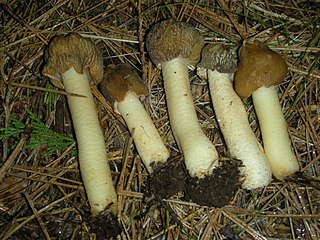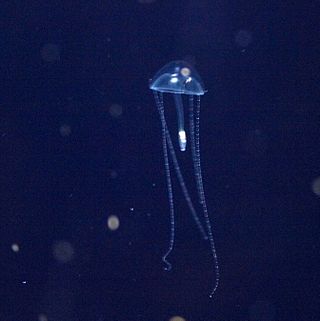
Podocarpus latifolius is a large evergreen tree up to 35 m high and 3 m trunk diameter, in the conifer family Podocarpaceae; it is the type species of the genus Podocarpus.

In zoology, a tentacle is a flexible, mobile, and elongated organ present in some species of animals, most of them invertebrates. In animal anatomy, tentacles usually occur in one or more pairs. Anatomically, the tentacles of animals work mainly like muscular hydrostats. Most forms of tentacles are used for grasping and feeding. Many are sensory organs, variously receptive to touch, vision, or to the smell or taste of particular foods or threats. Examples of such tentacles are the eyestalks of various kinds of snails. Some kinds of tentacles have both sensory and manipulatory functions.

The lion's mane jellyfish, also known as the giant jellyfish, arctic red jellyfish, or the hair jelly, is one of the largest known species of jellyfish. Its range is confined to cold, boreal waters of the Arctic, northern Atlantic, and northern Pacific Oceans. It is common in the English Channel, Irish Sea, North Sea, and in western Scandinavian waters south to Kattegat and Øresund. It may also drift into the southwestern part of the Baltic Sea. Similar jellyfish – which may be the same species – are known to inhabit seas near Australia and New Zealand. The largest recorded specimen was measured off the coast of Massachusetts in 1865 and had a bell with a diameter of 210 centimetres and tentacles around 36.6 m (120 ft) long. Lion's mane jellyfish have been observed below 42°N latitude for some time in the larger bays of the East Coast of the United States.

Semaeostomeae is an order of large jellyfish characterized by four long, frilly oral arms flanking their quadrate mouths. The umbrella is domed with scalloped margins, and the gastrovascular system consists of four unbranched pouches radiating outwards from the central stomach; no ring canal is present. They usually possess eight tentacles; four are per-radical and four are inter-radical.

The Pelagiidae are a family of jellyfish. Members of the family Pelagiidae have no ring canal, and the marginal tentacles arise from umbrella margin.

The Trochidae, common name top-snails or top-shells, are a family of various sized sea snails, marine gastropod molluscs in the subclass Vetigastropoda. This family is commonly known as the top-snails because in many species the shell resembles a toy spinning top.

Chrysaora colorata (Russell), commonly known as the purple-striped jelly, is a species of jellyfish that exists primarily off the coast of California from Bodega Bay to San Diego. The bell (body) of the jellyfish is up to 70 cm (2.3 ft) in diameter, typically with a radial pattern of stripes. The tentacles vary with the age of the individual, consisting typically of eight marginal long dark arms, and four central frilly oral arms. It is closely studied by scientists due to not much being known about their eating habits. A 15-foot-long specimen has been seen.

Plumularioidea is a superfamily of hydrozoans in the order Leptothecata.

Pseudococculinidae is a family of small sea snails or false limpets, marine gastropod mollusks in the superfamily Lepetelloidea.

Verpa conica, commonly known as the bell morel or the early morel, is a species of fungus in the family Morchellaceae. Sometimes mistaken for a true morel, this species is an “early morel” characterized by a cap resembling a thimble that is freely attached to the stem.

Argyropeza is a genus of small deep-sea sea snails, marine gastropod molluscs in the family Procerithiidae.

Velutina is a genus of small sea snails, marine gastropod mollusks in the family Velutinidae.
Cerianthus lloydii is a species of tube-dwelling sea anemone in the family Cerianthidae. It is sometimes called the lesser cylinder anemone and is found in shallow seas around the coasts of north west Europe.

Actinodendron arboreum, commonly known as tree anemone or hell's fire anemone, is a species of sea anemone in the family Actinodendronidae. It is native to the Indo-Pacific where it grows at depths of down to 28 metres (92 ft). Most sea anemone species are harmless to humans, but A. arboreum is highly venomous and its sting can cause severe skin ulcers.

Callioplana marginata is a species of flatworm polyclads belonging to the Callioplanidae family.

Phyllodiscus is a monotypic genus of sea anemones in the family Aliciidae. The only species is Phyllodiscus semoni, commonly known as the night anemone, which is native to shallow seas in the central Indo-West Pacific, such as Indonesia, the Philippines and southern Japan. It is venomous and can cause a painful, long-lasting sting to humans. It is called unbachi-isoginchaku in Japanese which translates as "wasp-sea anemone".

Liriope is a genus of hydrozoan in the family Geryoniidae. It contains only one species, Liriope tetraphylla.

The Enthemonae is a suborder of sea anemones in the order Actiniaria. It comprises those sea anemones with typical arrangement of mesenteries for actiniarians.
Kaburakia excelsa, the giant flatworm or giant leaf worm, is a species of flatworm found on the lower shore and shallow water in the eastern Pacific Ocean. It occurs on the lower shore and shallow sub-littoral zone.
Haliscera bigelowi is a species of deep sea hydrozoan of the family Halicreatidae.
















